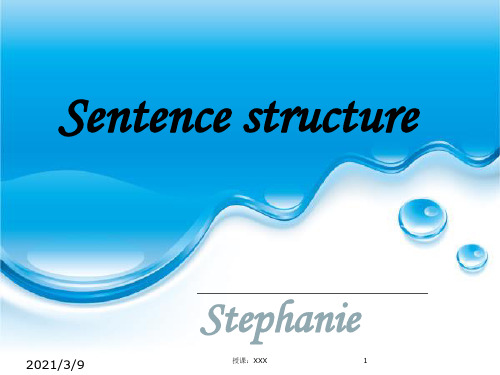高中英语句子成分和结构讲解PPT课件
合集下载
英语句子成分及结构解析ppt课件

Thank you !
(二).谓语
谓语(predicate) 或谓语动词(predicate verb) 的位置一 般在主语之后。谓语由简单动词或动词短语(助 动词或情态动词+主要动词)构成。 1.由简单的动词构成。 2.由动词短语构成的谓语。 3.英语常用某些动作名词代替表动态的谓语动词, 表生动。这种动作名词之前常用没有多大意义的 动词have, get, take, give 等。如: 注意:谓语动词要与主语的人称和数一致。
第一种:S+V (主语+谓语动词)
第二种:S+V+O (主语+谓语动词+宾语)
第三种:S+V+P (主语+连系动词+表语)
第四种:S+V+InO+DO (主语+及物动词+间接宾语+直接宾语)
第五种:S+V+O+OC (主语+及物动词+宾语+宾语补语)
1 、第一种句型:主语+不及物动词(S+V) 该句型所用动词都是不及物动词,其后当
play 演奏 order 命令
sing 唱歌 pay 为……而付钱
简单句的五种基本句型口诀
英语句子万万千,五大句型把线牵。句型种类为动词,后
接什么是关键;vt.又可分三类,单宾双宾最常见;还有宾
语补足语,各种搭配记心间。
5 第五种句型:主语+及物动词+宾语+宾语补 语 (S+V(及物动词)+O+OC)
(八).状语
1、状语(adverbial)是修饰动词、形容词、副词以及全句 的句子成分。。如:
The girl is improving remarkably. 这个女孩大有进步。 2.可用作状语的有副词、名词、代词、数词、形容词、
高中英语高考英语句子成分句法分析词类PPT课件

句子成分和句子分类
By lovemikky 2011年7月
1
预备知识点一:词类概述
词类 名词 冠词
英语名称 作用
n.
表示人或事物的名称
art.
用在名词前,起修饰或限定作用
例词 man,dog, tree, book a, an, the
代词 数词
pron. num.
代替名词或数词 表示数量或顺序
I, you, that, this, some, a few one, two, first
6
二、句子的分类 (按用途划分): 陈述句、疑问句、祈使句和感叹句
(一)陈述句:用来陈述一件事情,说明一个事实,表述说话
人的看法、和态度的句子。常用结构:主语+谓语+其它。 句末通常是句号。
Eg. 1. Tom can speak good English. 汤姆英语说的很好。 2. He is a student. 他是一个学生。3. I like football. 我喜欢足球。
状语 1. 用来修饰动词、形容词和 副词等的,表示事情发生 的时间、地点、原因、结 果、程度等等
2. 修饰动词时,位置在该动 词前后均可;修饰形容词 或副词,要放在它们之前
★ He runs quickly. 他跑地很快。 ★ She is very beautiful. 她非常漂亮。 ★ I will go there tomorrow.
3
(一)句子成分的特点和功能
句子 成分 主语 谓语 宾语
表语
特点和功能
例句
★ They are students.
1.是一个句子所叙述的主体,一般位于句首。★ 2.常用名词或相当于名词的词(动词不定时
By lovemikky 2011年7月
1
预备知识点一:词类概述
词类 名词 冠词
英语名称 作用
n.
表示人或事物的名称
art.
用在名词前,起修饰或限定作用
例词 man,dog, tree, book a, an, the
代词 数词
pron. num.
代替名词或数词 表示数量或顺序
I, you, that, this, some, a few one, two, first
6
二、句子的分类 (按用途划分): 陈述句、疑问句、祈使句和感叹句
(一)陈述句:用来陈述一件事情,说明一个事实,表述说话
人的看法、和态度的句子。常用结构:主语+谓语+其它。 句末通常是句号。
Eg. 1. Tom can speak good English. 汤姆英语说的很好。 2. He is a student. 他是一个学生。3. I like football. 我喜欢足球。
状语 1. 用来修饰动词、形容词和 副词等的,表示事情发生 的时间、地点、原因、结 果、程度等等
2. 修饰动词时,位置在该动 词前后均可;修饰形容词 或副词,要放在它们之前
★ He runs quickly. 他跑地很快。 ★ She is very beautiful. 她非常漂亮。 ★ I will go there tomorrow.
3
(一)句子成分的特点和功能
句子 成分 主语 谓语 宾语
表语
特点和功能
例句
★ They are students.
1.是一个句子所叙述的主体,一般位于句首。★ 2.常用名词或相当于名词的词(动词不定时
高中英语句子成分总结(共87张PPT)

The play has three acts.
This is her first trip to Europe. (代词、数词、不定式)
China is a developing country. (现在分词)
I have nothing to eat. (不定式)
Those who want to go to Tibet are to sign their names here. (定语从句)
school. ② She found it difficult to do the work. ③ They call me Lily sometimes. ④ I saw Mr. Wang get on the bus.
指出下列句中的状语 ①There was a big smile on her face. ②Every night he heard the noise
句子成分 与句子基本类型
句子
句子是由词按照一定的语法结构组成 的, 是表达一个完整概念的语言单位。
句子开头的第一个字母要大写;结尾 要有句号“.”、问号“?”或感叹号 “﹗”。
Tom likes rock music.
What are you doing now?
How beautiful it is!
(结果状语) Tsinhgeisntgudaenndtsdacnamcinegi.n(t伴o t随he状cl语as)sroom, If he goes, so will I. (条件状语)
句子成分之 同位语 放在名词后面, 与前面的名词指的是
同一人或物。代词、名词、数词和从 句都可以做同位语。
There is a baby. 这里有个小孩。
This is her first trip to Europe. (代词、数词、不定式)
China is a developing country. (现在分词)
I have nothing to eat. (不定式)
Those who want to go to Tibet are to sign their names here. (定语从句)
school. ② She found it difficult to do the work. ③ They call me Lily sometimes. ④ I saw Mr. Wang get on the bus.
指出下列句中的状语 ①There was a big smile on her face. ②Every night he heard the noise
句子成分 与句子基本类型
句子
句子是由词按照一定的语法结构组成 的, 是表达一个完整概念的语言单位。
句子开头的第一个字母要大写;结尾 要有句号“.”、问号“?”或感叹号 “﹗”。
Tom likes rock music.
What are you doing now?
How beautiful it is!
(结果状语) Tsinhgeisntgudaenndtsdacnamcinegi.n(t伴o t随he状cl语as)sroom, If he goes, so will I. (条件状语)
句子成分之 同位语 放在名词后面, 与前面的名词指的是
同一人或物。代词、名词、数词和从 句都可以做同位语。
There is a baby. 这里有个小孩。
高中英语高考英语句子结构分析(共35张PPT)

并列句的分类
1、表示连接两个同等概念,常用and, not only…but also…, neither…nor…, then等连接。 e.g. The teacher’s name is Smith, and the student’s name is John.
2、表示选择,常用的连词有or, either…or…, otherwise等。 e.g. Hurry up, or you’ll miss the train.
He worked hard all his life. (划线部分在 句中作状语,修饰动词worked)
He is a school student in No. 1 Middle School. (划线部分在句中作定语,修饰名 词student)
2) 并列句: 句型:简单句+并列连词+简单句
exam. 6) I like some of you very much. 7)If you study hard, you will pass the exam. 8)He goes to school by bike. 9)Though he is young, he can do it well.
位置 呢?
6、状语:它是修饰动词、形容词、副
词或全句用的。
1) I will go there tomorrow.
2) The meeting will be held in the meeting room. 3)The meat went bad because of the hot
weather. 4)He studies hard to learn English well. 5)He didn’t study hard so that he failed in the
高考英语八大句子成分和五个基本句型课件(共20张PPT)

only bones 结果状语 6. The students came into the classroom, singing and
dancing. 伴随状语 7. If he goes, so will I .条件状语 8. Though he is a child, he knows a lot. 让步状语
介词短语
4. I should advise you to get the chance. to do 不定式 5. I saw him going upstairs. 现在分词 doing 6. They found the house broken in. done 过去分词
宾语和宾语补足语一起构成动词的
• 在这类结构中最常用的系动词是: _“__变__化__”__类_g_:e_t/_b_e_c_o_m_e_/_t_u_r_n_/g_r_o_w_/g_o_________________. _“_感__官__”__类__: _ta_s_te_/_s_m_e_l_l/_f_ee_l_/l_o_o_k_/s_o_u_n_d_______________. “持续”类: ___________s_ta_y_/_k_e_e_p_/r_e_m_a_i_n___________________. 其他:(似乎)___S_e_e_m__a_p_p_e_a_r__ (证明是)_________
8. My first idea was that you should hide your feelings. 句子
(四)宾语 表示动作的对象,是动作的承受者。 宾语一般放在__动_词_/_动_词_短_语___之后。__介_词__词后也 会跟宾语。
1. She covered her face with her hands. 名词 n 2. We haven't seen her for a long time. 代词 pron 3. Do you mind opening the window?动名词 4. Give me four please. 代词和数词 5. He wants to dream a nice dream. to do不定式 6. We need know what others are doing. 句子 7. We should care more about our friends.
dancing. 伴随状语 7. If he goes, so will I .条件状语 8. Though he is a child, he knows a lot. 让步状语
介词短语
4. I should advise you to get the chance. to do 不定式 5. I saw him going upstairs. 现在分词 doing 6. They found the house broken in. done 过去分词
宾语和宾语补足语一起构成动词的
• 在这类结构中最常用的系动词是: _“__变__化__”__类_g_:e_t/_b_e_c_o_m_e_/_t_u_r_n_/g_r_o_w_/g_o_________________. _“_感__官__”__类__: _ta_s_te_/_s_m_e_l_l/_f_ee_l_/l_o_o_k_/s_o_u_n_d_______________. “持续”类: ___________s_ta_y_/_k_e_e_p_/r_e_m_a_i_n___________________. 其他:(似乎)___S_e_e_m__a_p_p_e_a_r__ (证明是)_________
8. My first idea was that you should hide your feelings. 句子
(四)宾语 表示动作的对象,是动作的承受者。 宾语一般放在__动_词_/_动_词_短_语___之后。__介_词__词后也 会跟宾语。
1. She covered her face with her hands. 名词 n 2. We haven't seen her for a long time. 代词 pron 3. Do you mind opening the window?动名词 4. Give me four please. 代词和数词 5. He wants to dream a nice dream. to do不定式 6. We need know what others are doing. 句子 7. We should care more about our friends.
高中英语句子成分和结构讲解课件(修改版,共31张)

①
表时间:yesterday, today, tomorrow…
我们是今天还是明天出去买东西啊?
Shall we go shopping today or tomorrow?
②
表地点:in China, at the airport…
我在教室里看见一个学生.
I saw a student in the classroom.
㈠主语(subject)
句子说明的人或事物, 主语一般位于______ 句首 。
Lily llikes her new bike. To learn English well is not easy.
(二)谓语(predicate):
由动词或动词短语充当,位置一般放于主语后面。
He works very hard.
谓语
The weather is very nice today.
谓语
He looked up the word in the dictionary.
谓语
(三)宾语( object )
动作的对象或承受者,由n.或相当于n.的词担任。
及物动词 或______ 介词 之后。 置于_________
How many do you want? - I want two. (数词) They sent the injured to hospital. (名词化的形容词)
• I found the book interesting.
• Do you smell something burning? • He made himself known to them.
(七) 同位语:(appositive) 我们有两个孩子,一男一女.
高中英语句子成分和基本结构2(共25张PPT)

It was he who helped me when I was in trouble
3.形容词性物主代词:用作句子的定语,之后必须 带名词,不能单独使用。 e.g This is my book. That’s his book. 4.名词性物主代词:=形容词性物主代词+名词:相 当于一个名词词组,只能单独使用,之后不能带 名词
5. I have a beautiful cat. I_ts______name is Mimi. These cakes are _it_s_____. ( it ) 6. Are these _th_e_i_r__ tickets? No. T_h_e__ir_s_ aren’t here. ( they )
Look! Those stamps are ___h_is___. ( he ) 18. So many dogs. Let’s count __th_e_m____. ( they )
19. I have a lovely brother. ___H__e___ is only 3. I like ___h_im____ very much. ( he ) 20. May I sit beside ___y_o_u____? ( you )
主代词
主代词
反身代词
单数
I
第一
人称
复数 we
me my mine myself us our ours ourselves
第二 人称
单数 复数
第三 人称
单数
复数
you you your yours yourself
you you your yours yourselves
he him his she her her it it its
英语《英语句子成分及基本结构》PPT课件

谓语(predicate)
谓语说明主语所做的动作或具有的特征和状态。 动词在句中作谓语,一般放在主语之后。谓语的 构成如下:
• 1、简单谓语:由一个动词或动词短语构成。如 :He practices running every morning. 2、复合谓语:由情态动词或其他助动词加动词 原形构成。如:You may keep the book for two weeks. He can speak English.
状语种类如下
1 We arrived at Shanghai at six yesterday.(地 点状语)(时间状语) 2 She didn’t go to the party because of the rain.(原因状语) 3 Mr Smith lives in America.(地点状语) 4 In order to catch up with the others, I must work harder.(目的状语) 5 He was so tired that he fell asleep quickly.( 结果状语)
英语句子成分及基本结构
(一)句子成分的定义
构成句子的各个部分叫做句子成分。句子 成分有主要成分和次要成分;
主要成分有主语和谓语;
次要成分有表语、宾语、定语、状语、补足 语和同位语。
(二)句子的具体成分
• 主语(subject):主语是一个句子所叙述的 主体,一般位于句首。
1 The room is very clean.
3 We saw him play soccer. (不定式) 4 We found math difficult.(形容词)
5 Mom makes me studying定语。定语 可由以下等成分表示:
高三英语语法总复习句子成分和基本句型讲解PPT课件

2021/5/24
5
第5页/共81页
表语:
• 表语说明主语是什么,或者怎么样,由名词,形容词,副词,介词短语,不定式,动 名词,短语,或者从句充当.表语位于系动词后面.
I am a teacher.
She is happy.
Everybody is here.
They are at home now.
getting cold. He often went hungry.
2021/5/24
21
第21页/共81页
3.能用不定式作表语的系动词有:appear, seem , get, prove, remain, turn out等。
She appears/ seems to be very young.
• 它可以由名词,形容词,副词,介词短语,不定式, 现在分词和过去分词充当. • If you let me go, I’ll make you king.
• Leave the door open.
•We found John out when we arrived.
• Make yourself at home.
第19页共81页20218120系动词后的表语可以是名词系动词后的表语可以是名词代词代词数词数词形容形容分词分词动名词动名词不定式不定式副词副词介词短语介词短语词组词组从句从句系动词系动词bebe可用于上述所有情况可用于上述所有情况
21021/5/24
第1页/共81页
什么是句子?
句子是由词按照一定的语法结构组成的,是 能表达一个完整概念的语言单位.句子的第
H语e充d当id,it也c可ar由e从fu句lly来. 充 当 .
Without his help, we couldn’t work it out.
高中语法句子结构专题讲解PPT课件

and, but, or
划
分
名词从句(宾,主,表,同谓)
复合句 副词从句(状语从句)
Composite sentence
2021/3/9
形容授课词:XX从X 句(定2语从句)
陈述句
一般疑问句
特殊疑问句
根 据
疑问句 选择疑问句
功
反义疑问句
能 划
祈使句
修辞疑问句
分 (无主句)
2021/3/9
感叹句
授课:XXX
Th20e21/f3/i9sherman painte授d课:hXXXis boat wh4 ite.
并列句 Compound sentence
•1. Jessica is reading a book, and Katrina is drawing a picture.
•2. Mrs. Li was very angry, but she said nothing.
Sentence structure
2021/3/9
Stephanie
授课:XXX
1
S+V(主+谓)
简单句 S+V+P(主+系+表) Simple sentence S+V+O(主+谓+宾)
S+V+o+O(主+谓+间宾+直宾)
根 据
S+V+O+C(主+谓+宾+宾补)
结 并列句 构 Compound sentence
2. What do you want to know? 3. Is he your brother? 4. What would you like to have, salad or beef? 疑问句 5. She is a good student, isn’t she? 6. Why me?
高中英语句子成分和基本结构2(共25张PPT)

• Mike 吃了三个苹果。 Mike ate three apples.
• 她画了一幅漂亮的画。
• She drew a beautiful picture.
4、主语+及物动词+双宾语(间接 宾语+直接宾语)(SVIOO)(SVOiO)
• 常带双宾语(直接宾语和间接宾语)的 动词(分为A、B两类) A:动词后加to
give 给 show给……看 send寄,打电报 bring带…… read读…… pass递给…… lend借给……
hand交给…… tell告诉…… return把……还给… write给……写信 throw扔……
leave留给……
•B:动词后加for make生产,制造…… buy买 do做 get得到 play演奏 order命令 sing唱歌 pay为……交钱
I want to learn English. 4.我真的想要学英语。
I really want to learn English. 5.把2、4合成一个句子。
I am a clever student and I really want to learn English.
I am a clever student who really want to learn English.
1.They work hard. 主 + 谓 2.The flower is dead. 主 + 系 + 表 3.Plants need water. 主 + 谓 + 宾 4.He gives me some seeds.
主 + 谓 + 间宾 + 直宾 • 5.We should keep the plants in the shade.
• 她画了一幅漂亮的画。
• She drew a beautiful picture.
4、主语+及物动词+双宾语(间接 宾语+直接宾语)(SVIOO)(SVOiO)
• 常带双宾语(直接宾语和间接宾语)的 动词(分为A、B两类) A:动词后加to
give 给 show给……看 send寄,打电报 bring带…… read读…… pass递给…… lend借给……
hand交给…… tell告诉…… return把……还给… write给……写信 throw扔……
leave留给……
•B:动词后加for make生产,制造…… buy买 do做 get得到 play演奏 order命令 sing唱歌 pay为……交钱
I want to learn English. 4.我真的想要学英语。
I really want to learn English. 5.把2、4合成一个句子。
I am a clever student and I really want to learn English.
I am a clever student who really want to learn English.
1.They work hard. 主 + 谓 2.The flower is dead. 主 + 系 + 表 3.Plants need water. 主 + 谓 + 宾 4.He gives me some seeds.
主 + 谓 + 间宾 + 直宾 • 5.We should keep the plants in the shade.
高中英语语法:句子的结构、成分和种类(共54张PPT)

一个完整的意义。一个句子一般由两部分 构成。即主语部分和谓语部分,这两部分 也叫做句子的主要成分。句子的次要成分 包括宾语、定语、状语、表语等。句子成 分是句子中起一定作用的组成部分。
3
一、句子成分
1.主语 主语是一个句子的主题,句子所诉说的主体,一般位于句首。但 是,在there be结构、主语不是疑问词的疑问句和倒装句中,主 语位于谓语、助动词或情态动词后面。 可用作主语的有名词、代词、数词、名词化的形容词、不定式、 动名词、短语或句子等。 On the first day, all students went to attend assembly.开学第一天, 所有的学生都去参加展会。(名词作主语。) Nothing is too difficult if you put your heart into it.世上无难事,只 怕有心人。(代词作主语。)
make。感官动词:feel,smell,look,taste,seem,appea与特征的词或短语。可用作定语的有形容
词、名词、代词、数词、副词、不定式、动名词、分词、介词短语和从句等。
6
一、句子成分
(2)复合谓语:由“情态动词/其他助动词+动词原形”或“系动词+表语” 构成的谓语叫复合谓语。 The weather gets warmer, and the days get longer.天气变暖了,白天变长了。 (“连系动词+表语”构成复合谓语。) He might be able to speak English.他也许能说法语。(“情态动词+动词原 形”构成复合谓语。) 3.宾语 宾语表示行为的对象或承受者,一般位于及物动词或者介词之后。可以用 作宾语的有名词、代词、数词、名词化的形容词、不定式、动名词或从句 等。 The Christian Church rejected his theory.基督教会不接受他的理论。(名词 作宾语。)
3
一、句子成分
1.主语 主语是一个句子的主题,句子所诉说的主体,一般位于句首。但 是,在there be结构、主语不是疑问词的疑问句和倒装句中,主 语位于谓语、助动词或情态动词后面。 可用作主语的有名词、代词、数词、名词化的形容词、不定式、 动名词、短语或句子等。 On the first day, all students went to attend assembly.开学第一天, 所有的学生都去参加展会。(名词作主语。) Nothing is too difficult if you put your heart into it.世上无难事,只 怕有心人。(代词作主语。)
make。感官动词:feel,smell,look,taste,seem,appea与特征的词或短语。可用作定语的有形容
词、名词、代词、数词、副词、不定式、动名词、分词、介词短语和从句等。
6
一、句子成分
(2)复合谓语:由“情态动词/其他助动词+动词原形”或“系动词+表语” 构成的谓语叫复合谓语。 The weather gets warmer, and the days get longer.天气变暖了,白天变长了。 (“连系动词+表语”构成复合谓语。) He might be able to speak English.他也许能说法语。(“情态动词+动词原 形”构成复合谓语。) 3.宾语 宾语表示行为的对象或承受者,一般位于及物动词或者介词之后。可以用 作宾语的有名词、代词、数词、名词化的形容词、不定式、动名词或从句 等。 The Christian Church rejected his theory.基督教会不接受他的理论。(名词 作宾语。)
- 1、下载文档前请自行甄别文档内容的完整性,平台不提供额外的编辑、内容补充、找答案等附加服务。
- 2、"仅部分预览"的文档,不可在线预览部分如存在完整性等问题,可反馈申请退款(可完整预览的文档不适用该条件!)。
- 3、如文档侵犯您的权益,请联系客服反馈,我们会尽快为您处理(人工客服工作时间:9:00-18:30)。
adj. / adv.
infinitive
V-ing / V-ed
clause
etc.
2
Members of a sentence
• 主语 subject • 谓语 predicate • 宾语 object • 表语 predicative • 宾补 complement • 定语 attribute • 状语 adverbial • 同位语 appositive
④表结果:to+do, v+ing, 从句
那个男孩从树上掉下来了,头撞到地上了.
The boy fell off the tree, striking his head against the ground.
⑤表目的:in order to, in order that, for the purpose 为了考入一个更好的学校,我必须更加努力.
.
10
(六)宾语补足语 (object complement)
• I found the book interesting. • Do you smell something burning? • He made himself known to them.
.
11
(七) 同位语:(appositive) 我们有两个孩子,一男一女.
②表地点:in China, at the airport…
我在教室里看见一个学生.
I saw a student in the classroom.
.
14
③表原因: because, as, for, since…
他因为生病所以今天没有去上学.
Because he was ill, he didn’t go to school today.
In order to get into a better school, I must
study even harder .
.
15
⑥表条件: as/so long as, if, unless,
.
9
(五) 表语(predicative)
1.be动词(am, is, are, was, were)
连系动词
2.表状态变化的动词 (get/become/turn/keep/remain/stay)
3.感官动词(look, smell, hear, feel…)
+表语
My sister is a nurse. She got angry.
动作的对象或承受者,由n.或相当于n.的词担任。 置于__及__物_动__词__或__介__词__之后。
How many do you want? - I want two. (数词) They sent the injured to hospital. (名词化的形容词) They asked to see my passport. (不定式) I enjoy working with you. (动名词) Did you write down what he said? (句子)
.
12
八. 状语:(adverbial)
状语是修饰动词,形容词,副词以及全句的句子成分;按 用途分,可分为时间,地点,原因,结果,目的,条件, 让步,程度,方式,伴随状况等。
.
13
①表时间:yesterday, today, tomorrow…
我们是今天还是明天出去买东西啊?
Shall we go shopping today or tomorrow?
.
7
He gave me some books.
↓
↓
间接 直接
宾语 宾语
通常情况下,指物的叫直接宾语,指人的叫间 接宾语。间接宾语多放在直接宾语之前。
●please pass me the book. ●He bought his girlfriend some flowers.
.
8
(四) 定语:(attribute) (Noun/Pronoun)
这是一节生动有趣的课. 前置定语 This is a lively and interesting class.
有一些难题要处理. 后置定语 There is something difficult to deal with.
Tips:形容词作定语时通常放在被修饰词的前面,而介词短语、 不定式短语则放在被修饰词之后。
.
5
(二)谓语(predicate): 由动词或动词短语充当,位置一般放于主语后面。
He works very hard.
谓语
The weather is very nice today.
谓语
He looked up the word in the dictionary.
谓语
.
6
(三)宾语( object )
We have two children, a boy and a girl.
那人是我的老师,他从来都不骑自行车.
The man, my teacher, never rides a bike.
当两个同一事物的句子成分放在同等位置时,一个句子成分可被用 来说明或解释另一个句子成分,前者就叫做后者的同位语。
.
3
I met my best friend Tom at the station yesterday.
↓↓ ↓
↓↓
↓
主谓 定 宾 同
状
语语 语 语 位
语
语
.
4
㈠主语(subject)
句子说明的人或事物,
主语一般位于__句__首__ 。
Lily llikes her new bike.
To learn English well is not easy.
英 /
The + adj
V-ing / Clause / Infinitive
Vi
主 语
谓 语
Vt
宾语
noun 宾语(直) 宾语(间) adj. / adv.
宾语 宾补
infinitive
系动词
表语
V-ing V-ed
Noun / Pronoun
noun etc.
The + adj
V-ing / Clause be / feel / seem / look
Infinitive
appear / stand / lie
become /get / grow / turn
go / come / remain/ keep . taste / smell etc.
pronoun
